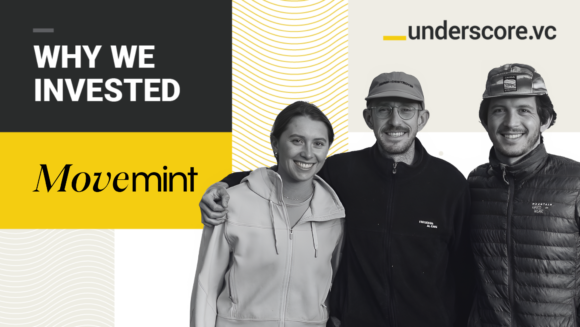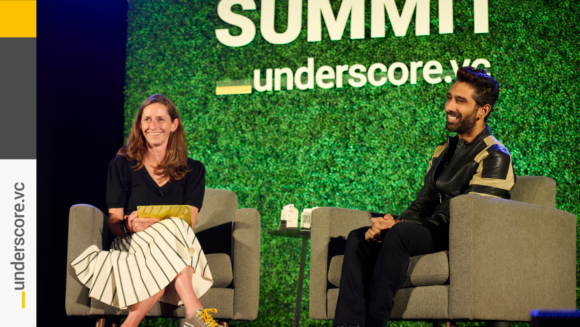As a New Entrepreneur, Where Do You Start?
Contributed by Michael Skok
I am often asked by prospective entrepreneurs how I got started and what they might learn from it. But my answer is: “Don’t follow me.” Follow your own path by finding a problem worth solving that you are uniquely qualified to solve* and can get passionate about. Then have the persistence and patience to pursue it.
- Problems
- Passion
- Persistence
- Patience
Problems
Teddy Roosevelt once said, “Far and away the best prize that life has to offer is the chance to work hard at work worth doing.” The key is to look around and get in front of a mega-trend and then look to solve a major problem or issue in order to fully leverage that trend. The good news is we don’t lack for major trends represented by multiple, multi-billion-dollar underlying markets. Take for example:
Living in a Resource-Constrained World
The world population will grow by nearly 30% in our lifetimes to 9 billion people. Population growth stresses natural resources and it will be compounded by economic development across Asia, India, and Africa – areas that are already stressed from a resource standpoint and by consumption per capita that is forecast to grow more rapidly than population, further straining resources. Using energy as a proxy for other resources – today, the United States consumes twice as much oil as China. But as China’s total energy demand surges 60% in the next 15 years, it will consume 70% more total energy than the US. Note that India, Indonesia, and Brazil (just to name a few) have higher rates of growth in per capita energy consumption than even China. According to the International Energy Administration, $620 billion a year in oil and gas investments are required just to fill this demand. Thus, game-changing innovation and entrepreneurship are mandatory in areas like solar (access to hard-to-get resources and low-cost energy storage systems). There are problems of equal magnitude in food, water, electronics, and healthcare – terrific opportunities for entrepreneurs and innovators.
Everything as a Service: The “Out-Servicing” Era
This is a revolutionary, highly-disruptive approach to technology and business models across multiple industries – all driven by software. Consider the post-PC era of tablets, mobile devices, and the “Internet of Things” – from cars to appliances to industrial equipment – that are connected to the cloud 24 x 7. It will allow new entrepreneurs to zero in on their core value with laser precision – innovate there and outsource or as I call it “out-service” the rest. It’s a major reason why the current $15 billion software-as-a-service revenue will leap to 10 times that as we move from discrete systems to continuous cloud services – another huge opportunity.
The Need To Scale Infrastructure
In order to enable and support the “out-servicing” era, whether it’s cloud computing, big data or mobile, there’s an insatiable appetite for content and connectivity. Today, there are about 9 billion mobile devices and that is forecast to grow to 50 billion connected devices in 2017. In 2012, networks handled more mobile data traffic – than in all preceding years combined and yet it’s forecast to grow at a 66% compounded rate until 2020. So, the opportunities to develop scalable, software-defined infrastructure, policy engines, data mining systems, content and applications from gaming, to education, medicine or wearable computers are huge going forward.
Know that along the way you will, of course, run into naysayers, challenges and even failure. To overcome those you will need a healthy dose of passion, persistence, and patience.
Passion: Pursue your passion, find your flow, trust your instincts.
In order to pursue these kinds of big problems, you will need to learn to tap your internal energy.
That energy may initially come from a basic need. For example, if you’re just starting out, it might be the need to pay off your student debt. And those needs are important if not critical. But in time, I believe our passion is the sustainable source of positive energy. If you’re not already aware of your passion, start by finding your flow.
Flow is literally that activity where you find yourself free-flowing and lose track of the time because it’s so natural. Composers find it in music. Athletes find it competing. Programmers find it coding. Where will you find yours? Here’s a paradox: you will only know when you find it because you will lose yourself in it. So it may take careful self-observation.
There’s a wonderful TED talk on this subject here.
It can take time to find your true passion. Enjoy the journey, the exploration and the learning about yourself. As you navigate, you will build your compass that will help you find your true north, your true calling in life.
And precisely because you focused on and took time to find that passion, you will build the conviction and instinct to pursue it. And you will need that as many people and things may conspire to divert your flow. Don’t let them; it will sap your energy. Eschew the cynics; find your own path to positive energy.
And always trust your gut instincts. They will ultimately serve you well, even though it may not be obvious at the time. Sometimes the hardest decisions are the best. And they may include what NOT to do. So often “less is more” in everything from products to life.
And in that vein, if the noise gets too great, keep taking things away until you find silence. Learn to meditate if necessary and in the peace, reconnect with your convictions. It is often in the pause or the gap that the “breakthrough thinking” has room to arise.
Persistence and Patience
Great entrepreneurs have a bias for action that’s admirable. They get in the flow and focus on doing a few things well and build on success. They ask more questions than they answer, and they listen more than they talk. But even with all that, it takes time to build something of impact and importance. And while you may get lucky, luck is a poor basis to build a life on. By contrast, patience and persistence really do pay off.
On average in our business, it takes 5-7 years to build a company of any significance. And typically even longer than that to build a sustainable, independent public company. So, while I hope you’ll find a breakthrough to prove those averages wrong, be compassionate with yourself if you find it’s taking longer and proving harder than you thought.
In the immortal words of Winston Churchill “if you’re going through hell, keep going!”
Some of our greatest investments took longer and traveled more tortuous and twisted paths than we could ever have imagined but then ended up being bigger successes than we ever thought possible. If you can just get back in the flow and enjoy the ride, you may never want it to end and that’s the basis to build something really enduring.
Wishing you a life of entrepreneurship, passion and the persistence and patience to enjoy the journey!
*If you’re not sure what you are uniquely qualified to do or perhaps you are just starting out in life and have no experience, read this.
This column was originally published in Forbes.
VC Startup Secrets Revealed
Contributed by Michael Skok
Entrepreneurs are in a position to make a significant impact on the world, but they’re also faced with intense challenges in doing so. Over the course of my career, I have confronted and seen many roadblocks that can arise on an entrepreneur’s path and latterly become engaged in learning and revealing how they might be avoided.
As a teen, I taught myself programming and built a variety of applications, from stock and bond portfolio management to retail and inventory control – learning with each success, and more importantly, each failure. Later, as an entrepreneur and VC, together with some great co-founders and teams, we founded and built companies that were acquired by some of the world’s largest technology corporations or went public and became leaders themselves.
Much of what I’ve learned during this multi-decade-long adventure I’m sharing openly as some simple “Startup Secrets” and Case Examples to frame the discussion with the goal of helping entrepreneurs to avoid common pitfalls.
Here are ten to get you going.
Startup Secret #1: Don’t Be Afraid To Say “No” More Than “Yes”
As a startup, you will be defined as much (or more) by what you say “No” to as what you say “Yes” to. Perhaps the single most important Startup Secret is to find your focal point. As an entrepreneur, you are naturally inclined to be ambitious and to want to tackle any and all challenges. However, as you build your company, focus on domains, segments, problems and other areas where you can specifically and uniquely differentiate yourself from the competition and gain repeatable traction. Don’t fall into the trap of being all things to all people: doing so can delay, distract or even lead to failure for your enterprise.
Startup Secret #2: Recognize what is right “4U”
As you work to position your startup and develop your value proposition, focus on addressing what I like to call the 4Us:
- Is the problem Unworkable? Does your solution fix a broken business process where there are real, measurable consequences to inaction? Will someone get fired if the issue is not addressed?
- Is fixing the problem Unavoidable? For example, is it driven by a mandate with implications associated with governance or regulatory control?
- Is the problem Urgent? Is it one of the top three priorities for spending?
- Is the problem Underserved? Is there a conspicuous absence of valid solutions to the problem you’re looking to solve?
To bring this to life, in a recent Startup Secrets workshop on value propositions, we featured one of our investments, a storage company, Actifio, whose ability to address the 4Us has propelled them to the top of their industry at a record pace. The team explained how they uniquely addressed each of the 4Us:
- Unworkable: There was no way to solve the problem with conventional storage architectures
- Unavoidable: Every enterprise with data to be accessed and protected creates the problem
- Urgent: Consuming the majority of storage budgets in an environment of constrained IT resources
- Underserved: Big players have a concrete dis-incentive to tackle in a way that serves the customer
Startup Secret #3: Think in 3D
Once you have determined the problem your venture is solving, define your solution. The most immediate question to ask is: What is your compelling breakthrough? A useful approach is to think of 3Ds: What unique combination of Discontinuous innovation, Defensible technology, and Disruptive business model are you bringing to bear, and what makes it truly compelling?
- Discontinuous innovations offer transformative benefits over the status quo by looking at a problem differently.
- Defensible technology offers intellectual property, for example, that can be protected to create a barrier to entry and unfair competitive advantage.
- Disruptive business models cause an “innovators’ dilemma” and/or yield value and cost rewards that help catalyze the growth of a business.
A fascinating example of 3D impact is around Google and how it changed the game for Microsoft. Years ago, Microsoft was dominant. However, through a disruptive business model, simple (defensible) technology, and innovative applications, Google has (and continues to) significantly cut into Microsoft’s business. Examples of Google’s 3D impact in action include Google Docs versus Microsoft Office and the disruptions of the phone business from Blackberry to iPhone to Android.
”Faster, cheaper and better” is likely a temporary advantage that is easily overcome by a competitor with deep pockets, but building an innovative business model can be a game-changer.
Startup Secret #4: Look for Non-Disruptive Disruptions
Evaluate the potential for success using the Gain/Pain ratio, which involves measuring the gain you deliver a customer versus the pain and cost for a customer to adopt, as illustrated in the diagram below. As an investor, I look for non-disruptive disruptions: technologies that offer game-changing benefits without requiring major modifications to existing processes or environments. Simply put: disruptive innovation should not be disruptive to adopt.
Non-disruptive is critical because whatever gain you deliver will be discounted by the pain of adopting your solution PLUS the inertia of vendor risk that every startup levies by the virtue of being small and unknown. A successful venture delivers an order of magnitude improvement over the status quo. If you can’t deliver a 10x promise, customers will typically default to “do nothing” rather than risk working with a startup or risk changing their current configurations.
Through Startup Secrets, we’ve created many case examples for startups that have experienced great success employing the Gain/Pain ratio methodology. From mobile app management leaders’ offerings to the largest web discussion platform, the Gain/Pain ratio can prove useful across a broad spectrum of industries.
Startup Secret #5: Focus on a Blatant, Critical Need: “Is it BLAC and White?”
Ideally, you want to be in the position of addressing problems that are BLAtant and Critical (especially for B2B), as those problems are far more acute than ones that are latent and aspirational. Blatant and critical problems stand in the way of business. They put careers and reputations at risk. Latent problems are unacknowledged, which means they often require costly missionary selling. Aspirational problems are optional, which is often the hardest place for a startup to sell.
Companies that view their value proposition through a “BLAC and White” lens are able to accelerate growth considerably. In fact, the same storage startup, Actifio, I referenced in Secret #2 did just that. They addressed blatant and critical storage issues tied to geometric data growth, unmet recovery times and the unwieldiness of petabyte-scale “Big Data.” The company addressed a white space that called for a solution that would address the “root cause” of the copy data problem. The result? Customers have embraced the new concept and the company has been on an upward trajectory ever since.
Startup Secret #6: If You Pick a Fight, Pick a BIG One
Big problems can lead to big opportunities. It often requires just as much work to go after a small market. Significantly painful problems are the source of great opportunity for entrepreneurs and have the potential to turn into really valuable solutions. They may not be easy to solve but often lead to true innovation.
The key is to look around, get in front of a mega-trend and then look to solve a related major problem or issue in order to fully leverage that trend.
Startup Secret #7: Focus on Your Minimum Viable Segment (MVS)
I find too many entrepreneurs who follow the lean methodology stuck in a product spin and become consumed with their Minimum Viable Product. While I often hear about the importance of product/market fit, I don’t believe enough consideration is given to the market side of this equation. While the MVP is critical, it’s missing its dance partner, what I call the Minimum Viable Segment (MVS).
Supporting Startup Secret #1, don’t be afraid to say no, MVS is about focusing on a market segment of potential customers that have the same needs into which you can repeatedly sell. Defining and focusing on your MVS is vital because, without it, potential users who have divergent needs will quickly pull your MVP in many different directions. In addition, since securing strong reference customers is critical in the early days of your Go-to-Market activities, you want them to reference each other, and they can’t if they don’t have the same needs.
In fact, one of the companies in my portfolio, Demandware, placed a significant emphasis on segmentation to find its initial customers. They remained true to the guiding principle of starting small within a niche before getting big within that market. With a goal of delivering with distinction, they focused on segments within segments, including high-growth retailers and brands within the segments: luxury, home, and lifestyle. Aligning the efforts of their sales and marketing teams behind that focus, they started with one brand; then that brand ambassador would talk to friends. Endorsements grew within retail segments and then beyond. Focusing on their MVS has today enabled them to break through the two-billion-dollar valuation mark.
Startup Secret #8: Hire for CQ (Cultural Quality)…Do QC (Quality Control)
Ideas are worth very little without people to execute them, a culture to guide the selection of talent and a big, bold vision to attract and unify the team. Human capital is what separates good companies from great ones – which is why establishing a strong culture to attract and retain the right people while unifying them behind an inspiring vision, is essential to any significant venture.
When evaluating a potential new hire for CQ, you need to ask yourself: does this person naturally align with your cultural values, work ethic and style of working? As part of this process, you should feel comfortable with (or better yet, inspired by) their passions, beliefs, and aspirations.
There are specific interview questions designed to help you assess CQ. The result of being mindful of CQ? A hire who will be additive to the culture you’ve worked hard to establish and who will have a positive impact on company morale and success.
A great example of culture fueling success is that of Amazon: the company’s physical manifestation of thrift underscores its approach to business. In fact, Jeff Bezos and the “door desk” came to symbolize Amazon’s frugal culture, which has been at the core of the company’s success.
Startup Secret #9: Hire 3As (Attitude, Aptitude, and Ability) and 3+s (+Aware, +Authentic, +Athlete)
In startup hiring, we all want to hire ‘A’ players – and this can be accomplished by looking at three important ‘A’s:
- Ability: Does the person have the right balance of IQ and Experience, Knowledge and Skills (EKS) required for the job?
- Aptitude: Being able to rapidly adapt and learn new skills and knowledge.
- Attitude: Pursuing breakout opportunities requires the right attitude toward things like problem-solving, persistence, and participation in a team.
Taking things a step further, most want to extend the notion of A players to look for A+ players. These attributes can vary based on role, but the three A+ traits I look for are: Athletes who are Self-Aware and truly Authentic:
- Athletes often triumph over experience and possess the agility to adapt to change.
- Self-Aware people are easy to work with, are open about their self-professed strengths and weaknesses, work well with others and are amenable to mentoring and coaching.
- Authentic people are genuine in all they do and demonstrate a sincere passion for their roles.
Startup Secret #10: Incomplete Standouts are Better than Complete Stand-Ups!
Many entrepreneurs think they need to have all answers, when, in fact, they don’t – especially when they seek funding. The nature of venture capital is high-risk. Part of that risk is not knowing the answers before you start. As VCs, we’re fine with the unknown, as long as people have the self-awareness and conviction to work through challenges as they arise. In fact, we expect there to be many gaps in thinking, in a variety of areas ranging from team strategy to business model during a company’s early stages.
Overall, it’s easy to start a company, but hard to build a business. From capital constraints to sales challenges, one needs to be able to accept that not having all of the pieces at the onset is okay, and these elements can be built out as you grow, as long as you have a clear roadmap and unifying culture.
It is probably apparent from this article that VCs like me love companies in their formative stage: they enable us to really collaborate with the entrepreneurs and get to know them as the business comes together. That said, even at that inception stage, there are some fundamental requirements VCs DO look for:
- A uniquely qualified person to back
- A great idea or insight into solving a significant problem or addressing a clear opportunity
- The beginning of a long-term vision
These ten Startup Secrets, while hopefully helpful, are not designed to be prescriptive. In your unique situation, they may not apply. Listen to your market and learn from it as you engage your stakeholders, but don’t forget that, as a founder, YOU are instrumental to your venture’s success. Congratulations on being an entrepreneur and the best of luck in finding your unique path to success.
Content from this column was originally published in PandoDaily.









